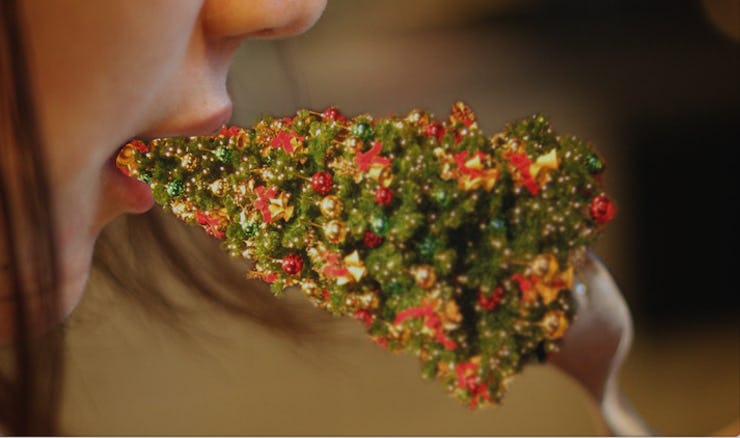How to Eat and Drink Your Christmas Tree
Pine trees are an excellent source of vitamin C.

An estimated 100 million American homes will put up a Christmas tree this holiday season. Of those trees, draped, decorated, and lit, about 81 percent will be artificial and 19 percent will be real, which means that 19 million coniferous trees are coming indoors. These trees will be beautiful and smell beautiful, but then they will become a hassle. Disposing of real trees is a pain — unless you eat them.
This has to be done strategically because not all Christmas trees are alike. According to the National Christmas Tree Association, Christmas trees typically are a fir, spruce, cypress, cedar, or pine tree. If you’re going into Christmas with the M.O. ultimately dining on your tree, you should purchase a white pine. This is the optimal Christmas tree to eat, giving you the most bang for your buck.
Pine trees also seem to be the favorite tree to eat by preppers and survivalists. This is largely because the white pine, latin name Pinus Strobus, is rich in vitamin C. You can get your intake of Christmas tree vitamin C by munching on the tree’s inner bark or brewing a tea with its needles.
To make this tea all you really need is to grab a bunch of needles, dice them up as fine as possible, then throw them in some boiling water. Let it all boil for a couple minutes; the water will soon turn into a light yellow color. And viola! You’ve made tea from your Christmas tree and you’ve lessened your chance of developing scurvy.
A brew of pine needle tea.
Getting to and dining on the inner bark of the tree is a bit more difficult. An important note for this part is, if you didn’t get a pine tree as your Christmas tree this year, surprise! You can actually eat the inner bark of most trees, so you could turn your spruce or fir into a bark-snack as well. The advantage of the pine tree, however, is that its phloem — the innermost layer of bark — contains Vitamin C. But all inner bark has nutrients beneficial to anyone willing to put in the effort and strip it from the tree.
The tree’s inner bark consists of second and third layers beneath a crunchy shell. This layer of phloem and cambium cells, which are edible, protect the wood of the trunk. These layers have also historically protected bellies — there is documented evidence of indigenous people around the world who have used bark as a food source.
Inner bark can be eaten fresh, dried, or roasted. If dined on fresh, it’s said to have a “sweetness and texture” of fresh coconut meat. For a finer dining experience, frying it in oil or butter to make bark jerky or roasting it to make crouton-like toppings is probably the way to go. At case can also be made for slicing the bark into strips, boiling it, and making a rustic pasta.
Make sure you only eat the inner bark of your tree.
Another thing you can do is grind down bark to use as a stew thickener or mix it into flour for baked goods. The Sami, the indigenous people of Scandinavia, added grounded pine bark to flour as an extender to make it last longer. And according to the Nordic Food Lab, not only does pine extend the shelf life of flours, it also adds a “distinctive warm, woody scent” with a dash of antimicrobial properties. The lab offers its own recipe for pine bark cookies here.
A final thing you can munch on are spruce tips — you can find these on evergreen trees like spruce and pine. Sure, these usually only pop up around spring but maybe you’ll get lucky with your tree. Spruce tips are the soft bits at the end of a branch. One thing you can do is harvest the tips when they are a nice lime green, put them in water and sugar, and make simple syrup. Or you can just straight up eat the tender bundles, either plain or candied.
And remember, you can also eat your dog.